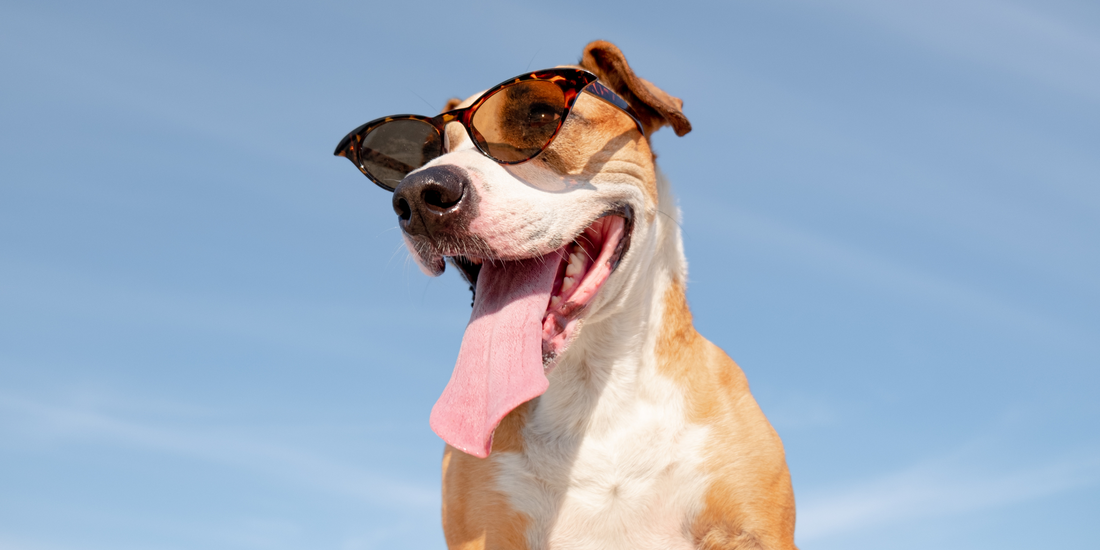Did you know that the skin is the largest organ for both humans and canines? We, humans, take precautions to protect ourselves from harmful UV rays. This is because overexposure to the sun can cause premature wrinkling and aging of the skin, age spots and increased risk of skin cancer. But should we be doing the same for our dogs? Can dogs get sunburned? Here are 11 questions answered about dogs and sunburns.
Can dogs get sunburned?
Yes, dogs can get sunburned, just like people. Although our dog's fur serves to protect their skin from UV rays, it's not always enough to prevent sunburn.
What dogs are at highest risk for dog sunburn?
Some dogs are more at risk for sunburn than others. These include:
- Hairless breeds (such as the Chinese Crested, Xoloitzcuintli, American Hairless Terrier)
- Dogs with thin coats and short fur (such as Greyhounds, Weimaraners, Pit Bulls, Boxers, etc.)
- Dogs with white fur
- Dogs with light or pink skin, especially on exposed body parts like the nose, muzzle, eyelids and ears (such as Dalmatians, Dogo Argentinos, etc.)
- Dogs that like to lay outside, especially those that lie on their backs exposing their bellies
- Dogs with hair loss, bald spots or scar tissue
- Dogs with shaved fur, such as those who recently underwent surgery or bloodwork
- Dogs with autoimmune diseases or genetic defects
Although these dogs are more at risk of sunburn than others, any dog can get sunburn and precautions should be taken for all pups.
What body parts are high risk areas for sunburn?
Dogs are most likely to get sunburned on exposed areas with little to no fur or thin fur. These include the:
- Nose
- Ears, especially the tips
- Belly
- Groin
- Inner thighs
- Eyelids, depending on breed
- Lips and exposed skin around the mouth, depending on breed
- Tip of the tail
- Anywhere else skin is exposed
What are the symptoms of a sunburned dog?
Signs of sunburn in dogs can be similar to that in humans, often showing up within an hour and potentially peaking within three days:
- Redness (typically the first and most obvious sign)
- Warm to the touch
- Tenderness and sensitive skin
- Blisters and skin ulcers
- Inflammation
- Licking the area
- Hair loss
- Dry, cracked skin
- Vocalization of pain
- Skin infections
- Abnormal lumps or tumors (skin cancer)
It's always a good idea to contact your vet if you think your dog has sunburn.
What is the treatment for sunburn in dogs?
Treating your dog's sunburn depends on the severity of it. Minor sunburns may benefit from cold compresses, which can cool down the affected area, prevent any more damage from occurring and reduce pain. Vitamin E or products created specifically for pet burns, such as creams and ointments, can also be helpful.
It's recommended you call your vet if your dog has been sunburned, but it is especially important if the sunburn is more severe. They may want to treat it with a cortisone product to prevent inflammation and antibiotics or antibacterial cream for any secondary infections that may occur. They may even need to administer intravenous fluids to rehydrate or stabilize a badly burned dog.
What are the risks of sunburn in dogs?
When a dog get sunburned, it's not only painful but can also cause more serious issues. These include:
- Hair loss
- Scaly skin
- Skin cancers (such as squamous cell carcinoma, malignant melanomas, and hemangiomas)
- Exacerbation of preexisting health conditions (such as autoimmune disorders and dermatitis)
Is sunscreen a good way to protect dogs?
As long as it's pet-safe, sunscreen is a great option for protecting dogs from UV rays, especially for those with light skin and fur. It's extremely important that you use dog sunscreen, as human ones contain toxic ingredients and dogs often lick the sunscreen after application. For example, zinc oxide can cause severe anemia and even be life threatening. Other ingredients to avoid include para-aminobenzoic acid (PABA), octisalate (a type of salicylate) and alcohol (which can dry out the skin and coat). There are plenty of dog sunscreen options, with many having an equivalent SPF of 30+ (the higher the more protective) as well as unscented options for dogs with sensitive skin and waterproof ones for dogs that like to go in the water.
A few recommended and highly rated dog-safe sunscreens out there include:
- Epi-Pet K-9 Care Spray Sunscreen (this is what we use!)
- Only FDA-compliant dog sunscreen on the market
- Equivalent to SPF 30+
- Quick dry formula
- Non-greasy or oily
- Water and sweat resistant
- Vanilla scent
- Contains skin and coat conditioner ingredients
- Made in USA
- My Dog Nose It! Moisturizing Sun Protecting Balm
- Formulated with all natural ingredients, such as carnuba wax, coconut oil and more
- Water resistant
- Paraben free
- Can be used for cracked noses and paws as well
- Made in USA
- Petkin Dog Sunscreen Sunmist and Sunstick
- Gentle formula
- Equivalent to SPF 15
- Non-greasy or sticky
- Non-aerosol bottle
- Vanilla coconut scent
Pro Tip: If you aren't sure what product to go for, consult your vet.
How do I apply sunscreen on dogs?
Applying sunscreen to dogs can be a challenge, since they often don't want to be forced to stay still. Go slowly and carefully when applying and ask someone to help if possible. A few more tips:
- Start by testing a small amount on one area. Watch for signs of allergic reactions.
- Once in the clear, apply the sunscreen to your dog's most vulnerable spots (e.g. the nose, ear tips, skin around his lips, belly, groin, inner thighs and anywhere where skin is exposed or pigmentation is light)
- Be extra careful around the eyes when applying to your dog’s face. Only apply externally and avoid going inside their ears and nose.
- Once applied, make sure your dog doesn't lick off the sunscreen for 10 to 20 minutes until absorbed. Also wait to let your dog outside until after this time frame to ensure the product will work.
- Reapply sunscreen every four to six hours and after any swimming.
What are some UV-protection alternatives to dog sunscreen?
If you're looking for alternatives to sunscreen or your pup continually licks it off, there are some options. These include UV-protective clothing, paw booties, goggles (or "doggles") and hats.
- UV-protective clothing typically comes in the form of shirts and body suits to cover large areas of the body. They are typically made from durable fabrics that protect against UVA and UVB rays, but are often light-weight and quick-drying. UV-protective clothing have SPF equivalents as high as 40+ and reduce the need for sunscreen.
- Booties not only protect your dog's paws from hot surfaces (like pavement, asphalt, concrete and even sand), but also from the sun. They are flexible enough for full range of motion and come in sock slip-on and rubber glove versions for dogs who aren't fans of traditional booties.
- Doggles (dog goggles) and hats protect your dog's eyes, which are quite sensitive to light, by shading them from the sun. These items can also protect some sensitive skin on the face and help your dog see better in bright conditions, much like they would for humans. Many dogs don't like them though, so you may need to do some training to get your dog comfortable in them.
Pro Tip: Doggles are a highly recommended for dogs with eye conditions, such as cataracts and Chronic Superficial Keratitis (also known as CSK or pannus, which is an autoimmune disease that affects the cornea).
It's important to note that these will not protect all of your dog's vulnerable areas. For instance, you'll still need to protect your dog's nose, ears, belly, groin, inner thighs, tip of the tail, lips and anywhere else skin is exposed.
What are other ways to protect your dog from sun exposure?
Although sunscreen and UV-protective gear provide good sun protection, there are more surefire ways to protect your dog. In addition, they will not prevent your dog from overheating or heatstroke, of which older dogs and puppies are more at risk. So it's important to be careful in the sun. A few good rules of thumb:
- Limit sun exposure during peak sun hours from 10 AM to 4 PM, when the sun is strongest (except for quick potty breaks). The best way to do this is to keep them indoors and next best is to keep them in the shade.
- Make sure your dog always has access to fresh water when outdoors.
- Also make sure your dog has a shady spot to retreat to. If there isn't any shade, you can set up a tent, umbrella or sun cover. You can also buy a raised dog bed with a canopy, which not only provides shade but also keeps your dog off the hot ground.
For more tips, check our articles on summer heat safety and summer essentials.

